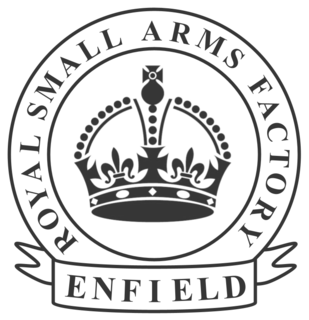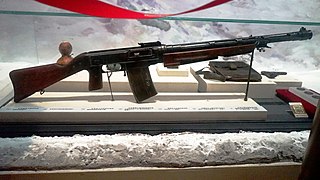
The Birmingham Small Arms Company Limited (BSA) was a major British industrial combine, a group of businesses manufacturing military and sporting firearms; bicycles; motorcycles; cars; buses and bodies; steel; iron castings; hand, power, and machine tools; coal cleaning and handling plants; sintered metals; and hard chrome process.

The Bren gun was a series of light machine guns (LMG) made by Britain in the 1930s and used in various roles until 1992. While best known for its role as the British and Commonwealth forces' primary infantry LMG in World War II, it was also used in the Korean War and saw service throughout the latter half of the 20th century, including the 1982 Falklands War. Although fitted with a bipod, it could also be mounted on a tripod or be vehicle-mounted.

The Lewis gun is a First World War–era light machine gun. Designed privately in the United States though not adopted there, the design was finalised and mass-produced in the United Kingdom, and widely used by troops of the British Empire during the war. It had a distinctive barrel cooling shroud and top-mounted pan magazine. The Lewis served to the end of the Korean War, and was widely used as an aircraft machine gun during both World Wars, almost always with the cooling shroud removed, as air flow during flight offers sufficient cooling.

The Universal Carrier, also known as the Bren Gun Carrier and sometimes simply the Bren Carrier from the light machine gun armament, is a common name describing a family of light armoured tracked vehicles built by Vickers-Armstrongs and other companies.

The Royal Small Arms Factory (RSAF) was a UK government-owned rifle factory in Enfield, adjoining the Lee Navigation in the Lea Valley. The factory produced British military rifles, muskets and swords from 1816. It closed in 1988, but some of its work was transferred to other sites.

The Vickers K machine gun, known as the Vickers Gas Operated or Gun, Machine, Vickers G.O. .303-inch in British service, was a rapid-firing machine gun developed and manufactured for use in aircraft by Vickers-Armstrongs. The high rate of fire was needed for the small period of time when the gunner would be able to fire at an attacking aircraft. The weapon was also adopted for land use during World War II.

The two most common rifles in the world are the Soviet AK-47 and the American M16. These Cold War-era rifles have been used in conflicts both large and small since the 1960s. They are used by military, police, security forces, revolutionaries, terrorists, criminals and civilians alike and will most likely continue to be used for decades to come. As a result, they have been the subject of countless comparisons and endless debate.

The ZB vz. 26 was a Czechoslovak light machine gun developed in the 1920s, which went on to enter service with several countries. It saw its major use during World War II, and spawned the related ZB vz. 27, vz. 30, and vz. 33. The ZB vz. 26 influenced many other light machine gun designs including the British Bren light machine gun and the Japanese Type 97 heavy tank machine gun. The ZB-26 is famous for its reliability, simple components, quick-change barrel and ease of manufacturing. This light machine gun in the Czechoslovak army was marked as the LK vz. 26. ZB vz. 26 is incorrect nomenclature because "ZB-26" is a factory designation, while "vzor 26" or "vz. 26" is an army designation.

The Besa machine gun was a British version of the Czechoslovak ZB-53 air-cooled, belt-fed machine gun.

The Charlton automatic rifle was a fully automatic conversion of the Lee–Enfield rifle, designed by New Zealander Philip Charlton in 1941 to act as a substitute for the Bren and Lewis gun light machine guns which were in severely short supply at the time.
The Lithgow Small Arms Factory, or Lithgow Arms, is an Australian small arms manufacturing factory located in the town of Lithgow, New South Wales. It was created by the Australian Government in 1912 to ease reliance on the British for the supply of defence materials.

An assault rifle is a selective fire rifle that uses an intermediate cartridge and a detachable magazine. Assault rifles were first put into mass production and accepted into widespread service during World War II. The first assault rifle to see major usage was the German StG 44, a development of the earlier Mkb 42. While immediately after World War II, NATO countries were equipped with battle rifles, the development of the M16 rifle during the Vietnam War prompted the adoption of assault rifles by the rest of NATO. By the end of the 20th century, assault rifles had become the standard weapon in most of the world's armies, replacing full-powered rifles and sub-machine guns in most roles. Some of the most successful assault rifles include the AK-47, M16, IMI Galil and Heckler & Koch G36.
During the Second World War, the Canadian Army used the Rifle Section as its smallest organized formation of combat infantry soldiers. The organization was substantially similar to that of the Australian Army and the British Army with three sections to the platoon and three platoons to the Rifle Company.

The Vickers–Berthier (VB) is a light machine gun that was produced by the British company Vickers-Armstrong. It was adopted by the British Indian Army and saw combat during World War II.

The L1A1 Self-Loading Rifle, also known as the SLR, by the Canadian Army designation C1A1 (C1) or in the US as the "inch pattern" FAL, is a British version of the FN FAL battle rifle produced by the Belgian armaments manufacturer FN Herstal. The L1A1 was produced under licence and has seen use in the Australian Army, Canadian Army, Indian Army, Jamaica Defence Force, Malaysian Army, New Zealand Army, Rhodesian Army, Singapore Army and the British Armed Forces.

The SIG KE7 is a light machine gun designed and manufactured in Switzerland in the decade before the Second World War. Although exported, it was never used by the Swiss Army.

The Johnston Model D1918 was a light machine gun. It is a rare and little-known weapon with scant information available on it. It is best known for its resemblance to the Lewis Gun, having a similar gas-operated action and a barrel surrounded by a cooling shroud.

Václav Holek was a Czech firearm engineer. He is considered to be the most eminent weapons designer of the pre-war Czechoslovakia. He had applied for more than 75 patents during his active years.
The No. 7 Bayonet was a bayonet primarily used with the Sten Mk V submachine gun. However, it could be used on the No. 4 Lee-Enfield, but only for ceremonial purposes as the bayonet obstructed the path of the .303 round fired from the gun.















